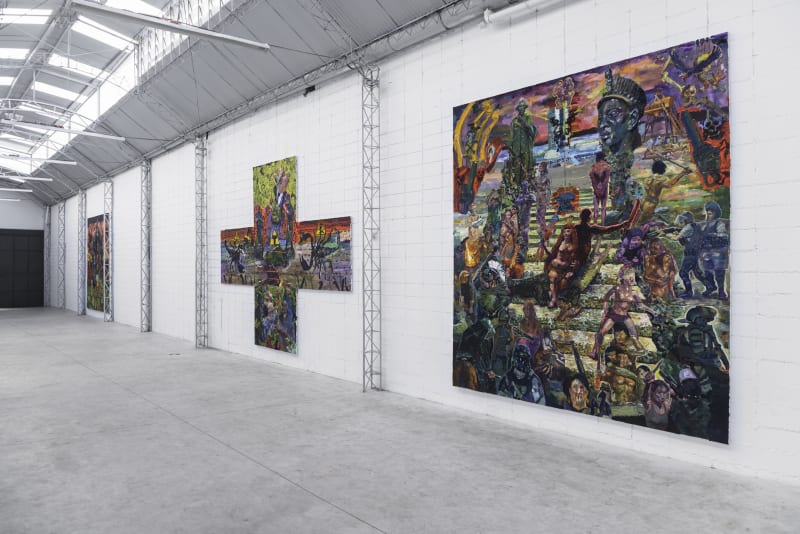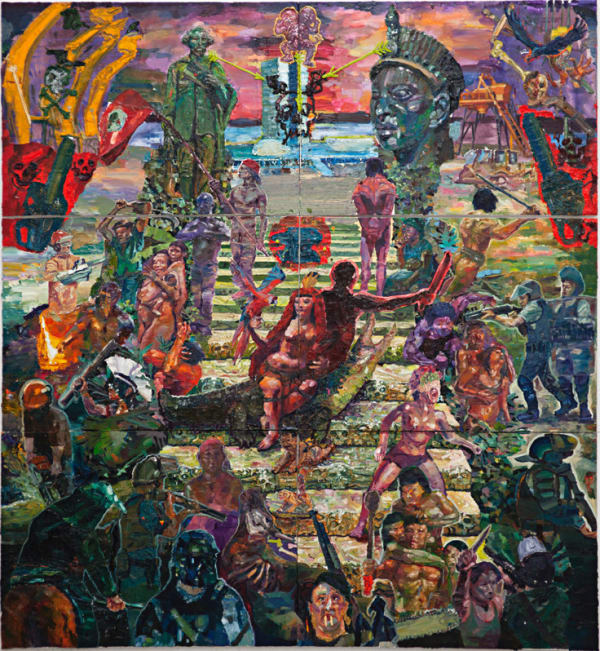Teatro Nagô-cartesiano e o Corte Azimutal do Mundo Thiago Martins de Melo
Mendes Wood DM is delighted to present "Teatro Nagô-cartesiano e o Corte Azimutal do Mundo" Brazilian artist based in Sao Luis Thiago Martins de Melo second solo show at the gallery.
Among the Brazilian artists currently practicing in the field of painting, Thiago Martins de Melo applies himself most notably to densely narrative and polysemic canvases. Fundamental to his work is its plasticity. His oversized diptychs, triptychs and polyptychs strive for independence from the imposed dichotomy represented by the mind versus the body. This is not a quest for naivety in his work, but an assumption that this separation simply does not exist. The violent theatre of flesh that overflows the span of his canvases, and the violets, greens and hysterical oranges of his palette, overcast with the toxic light of his hometown, São Luís do Maranhão – so rich, so poor, frozen in time, decrepit and ravenous – speaks of the urgency of his political commentary. This is the light of an Amazonian city abandoned and raped by recent history.
Martins de Melo’s cosmology seems to encompass everything. Visuality is raped by a frightening semiotic jungle of syncretic voices, a rich cultural hybridity that flirts with philosophy, esotericism, literature, religion, psychology, politics and many other forms of knowledge. His painting, full of libido, rebels against unison forms, exploding and pulsing with the tension of material, cultural, spiritual, political and ethical struggle. Archetypes and obscure symbols – sublime and subliminal – merge with visionary narratives, utopian and anti-hegemonic.
He advocates moral and social solidarity, urges revenge, makes spiritual evocations and offerings, chronicles tragedies and ethnic clashes in full and chaotic interaction, calling everyone who contemplates his paintings to participate in a ritual – emotional and rational – according to his or her particular angle and private world.
Inspired by Walter Benjamin, one could say that Martins de Melo performs ‘a tiger's leap into the past’, invoking an image ‘that unexpectedly offers itself to the historical subject in a moment of danger’. His creations seem to be located in a backward-looking time, drawing on cultural memory and using the historicity of painting to reinvent in the contemporary world historical characters, culturally diverse peoples and Brazilian spiritual entities – peasant, mythical, indigenous and black. Armed with their memories and hauntings, his characters are created in order to reclaim their stories and forms of expression, acting within a scenario summoned from the painter’s utopian and idealistic dream vision. They are called to return to the battlefield within the artist's works, communicating their fight to the art world and to the intellectual elite.
Martins de Melo’s enemies are colonels, politicians, traditional oligarchic figures, racial and cultural prejudice, land invasion, tractors and aggressive industrialization by miners and loggers. By inner necessity, he embarks on his pictorial battle against them with a self-exposure that is visceral, acting as a witness and character by depicting himself and his wife as anti-establishment figures attacking national institutions – killing pigs in the Brazilian Senate, for example, burning the chapel of an enslaving landowner, or destroying the bust of a former president and current corrupt senator with a jackhammer. He expresses through the carnality of his paints the pains of physical and cultural oppression, of silence and misunderstanding, the anguish of forced labour and endurance. He portrays the poetics of exile through theatricality, and postcolonial struggles through catharsis. With deep artistic commitment, he addresses taboos and prejudices, using his afrocaboclos heroes, peasants and indigenous characters to try to understand what he calls ‘the invention of the white Brazil’ that has made Pindorama ‘schizobrazil’ or ‘psychobrazil’.
There is a psycho-geographical aspect of Martins de Melo’s work where the metaphysical dimension and the projection of an inner world coexists, revealed by the signs and archetypes present in his paintings. The artist seems to reside in an ‘inter-locale’ – a place of boundaries between the real and unreal. He transits between these boundaries with what is essentially an autobiographical approach, addressing domestic and psychological themes of love, gender, family and spirituality, as well as the reality of everyday life in the Brazilian Amazon. The pictorial sign is used in his works to break taboos and as a communication tool, while the ‘invisible’ serves as a magic pictorial ebó (offering) that embodies the wishes of the artist. These narrative signs reflect the complexity of the everyday Amazon experience, revealing elements that are hidden, unknown, despised or ignored.
— Pedro Mendes and Viviane Vazzi







